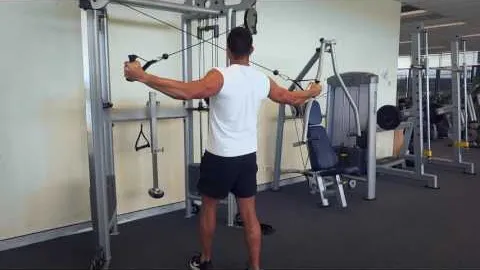
The high cable rear delt fly is an excellent exercise for targeting the rear deltoid muscles, which are located at the back of your shoulders. This exercise is commonly performed using a cable machine with adjustable pulleys, making it suitable for individuals of all fitness levels.
Incorporating high cable rear delt flys into your workout routine can offer several benefits. Not only does it effectively isolate and strengthen the rear deltoids, but it also helps improve posture and prevent muscle imbalances. Additionally, by engaging the rear deltoids, this exercise enhances overall shoulder stability and aids in injury prevention.
To perform a high cable rear delt fly, follow these steps:
Maintaining proper form and execution is crucial to maximize the effectiveness of the high cable rear delt fly exercise and prevent injury. Follow these tips to ensure you're performing the exercise correctly:
To effectively target your rear deltoids and reap the benefits of the high cable rear delt fly exercise, incorporate it into your upper body or shoulder-focused workout routine. Here's an example of how you can schedule this exercise:
Although the high cable rear delt fly is a safe and effective exercise when performed correctly, it's essential to pay attention to safety considerations. To avoid injury:
The high cable rear delt fly is a valuable exercise for targeting and strengthening the rear deltoid muscles. By incorporating this exercise into your workout routine, you can improve your shoulder stability, muscle balance, and overall posture. Remember to focus on proper form and execution, and gradually increase the weight to challenge your rear deltoids appropriately. Enjoy the benefits of this exercise and watch your shoulder strength and aesthetics improve over time!
If you're looking for a gym, fitness club or yoga studio, you've come to the right place.
You can find information about gyms in your area. Browse catalog of gyms and find gyms with classes which are you looking for.
On gym page you can find simple information like address, phone or website. You can find list of available classes. You can check availability of personal training or small group classes. On place page you can also see information about open hours.
You can find gyms near you with amenities, courts, studios and equipments.
Use our map to find gym at your city or district.
In Gym Navigator you can find list of exercises with movies for many body parts.
You can browse exercises catalog and find exercises the best of you.
You can also find exercises grouped into workout plans, which you can use to improve you body. Each routine show you exercises one by one and give you possibility to count you progress and count down rest time.